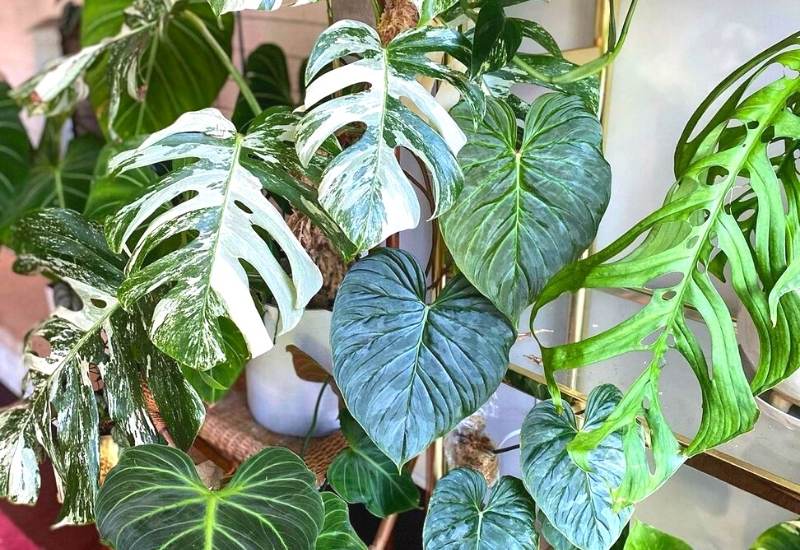
Philodendron is by far one of the most popular houseplants all over the world. We all love the plants from this large exotic genus for its beautiful, large glossy leaves.
In fact, Mother Nature has been particularly creative with the foliage of philodendron. Most plants adapt to indoor places very well, even if light is not strong, and some have colored leaves too.
By the way, did you know that “philodendron” means “tree of love”? But with so many species, which variety will be the one for you?
Part of Araceae family Philodendron is large genus flowering plant contains over 489 known species, and many are still unknown. Quite a few of these have found their way from their native tropical forests to our homes.
The two main types of philodendrons are vining and non-climbing varieties. Rather than growth habit they comes in an array of size, shape and sometimes even the coloring of the leaves.
While most species are perfectly suited for surviving and even thriving in less than tropical conditions but there are a that can be little more hard to keep alive when it comes to water and light.
To help you to choose the types of philodendron that is best for your home, we rounded up 20 easy to grow philodendron varieties to consider for indoor growing, along with our best tips to identify specific varieties to learn what care they need.
Related: Difference Between A Philodendron And A Pothos
A general Look at Philodendron
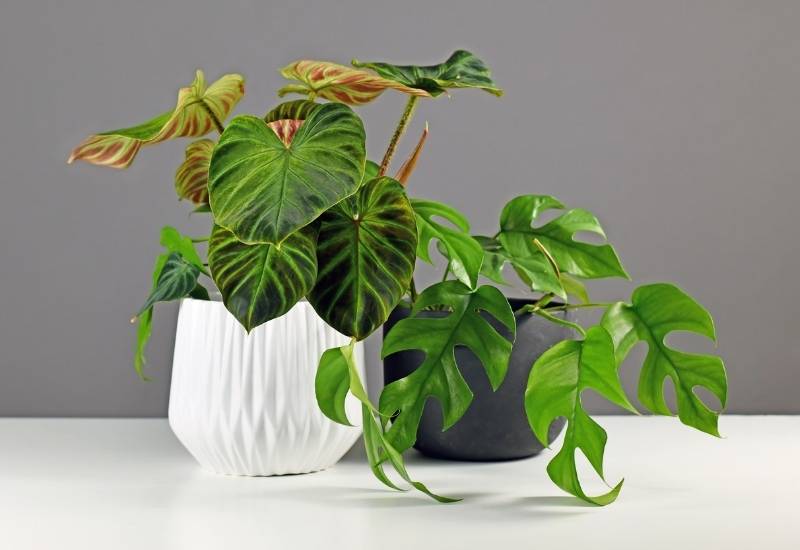
Philodendron plants come from Central and South America, where they grow in rich, hot and moist rain forests.
Some grow directly on trees (they are epiphytic), others are terrestrial and yet others are hemiepiphytic. This means that they are born on trees, but then they send roots down to the ground.
This leads us to a key distinction between the varieties of this genus:
This is a very important factor in your choice.
They are part of the Araceae family, which is famous for its large and glossy leaves. And they are no exception. The leaves of philodendron can be lobed or not, cut or not, sometimes pinnate, sometimes not. Pinnate means that they have divisions.
The overall shape of the leaves can be oval, lanceolate or spear shaped. As we said, size and color too will help you distinguish them.
In the wild, they also flower and fruit, but this will not happen indoors. It’s a strange habit of this exotic plant.
Philodendron Plant Care Guide
The different species and varieties of the philodendron genus like similar conditions. So, we can look at how to grow them all right now, rather than one by one.
All these apply for all the twenty varieties you are going to meet now. If there are exceptions, I will tell you in the description. Ready?
25 Philodendron Varieties To Grow Indoors
From upright or trailing types to different color, shape and size, here are 20 great philodendron species and cultivars (with pictures and common names) to consider for indoor growing.
1: Green Heartleaf Philodendron (Philodendron hederaceum)
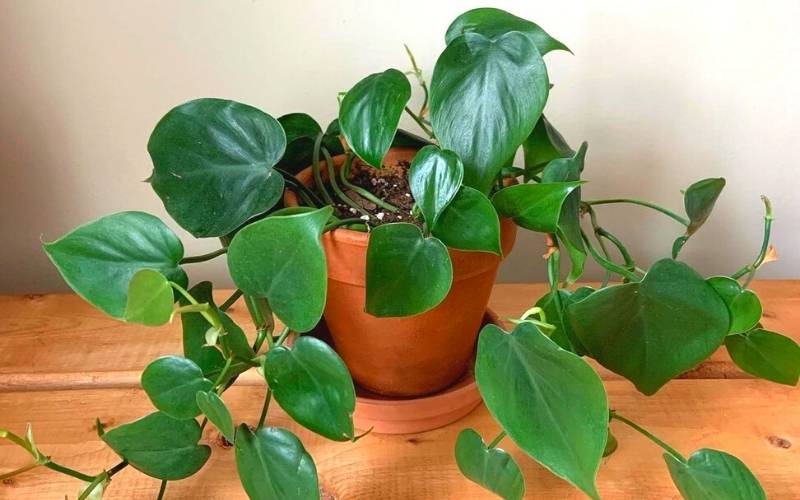
Green heartleaf philodendron, a.k.a. sweetheart plant, is the most common, most classical species of this plant. The name says it all… It is in fact a vine with leaves that look like hearts, and it can be confused with pothos. The foliage is bright green and it is also very rich and lush.
It loves very humid places, and in fact it is a perfect bathroom plant. Also, this variety prefers low light conditions, which makes it good for corridors and darker rooms too.
2: Philodendron Xanadu (Philodendron Bipinnatifidum)
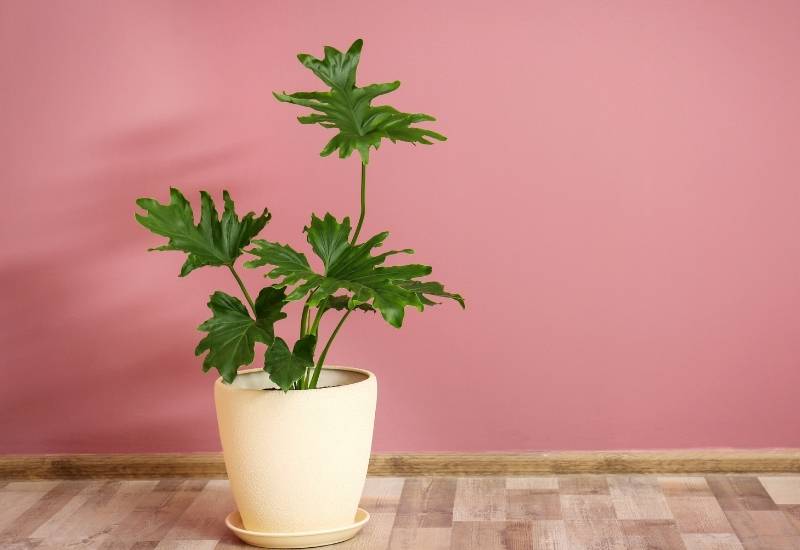
Philodendron Xanadu has an amazing presence. The leaves are very long, dark green and split, with very, very deep lobes. They look very strong, thick and sculptural. Each leaf grows on a long and strong stem which comes directly from the ground, forming a round shaped “dome” of striking leaves.
It is a bold statement in any room. It cannot be missed by any visitors, and it can even be the big protagonist in large spaces.
3: Philodendron Pink Princess (Philodendron erubescens)
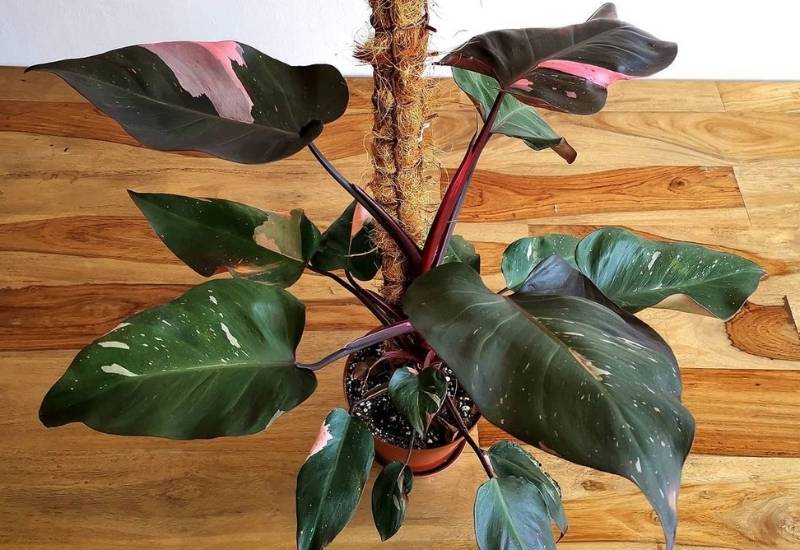
Philodendron pink princess has a romantic and intriguing look. It is a variegated philodendron variety with elongated heart shaped leaves.
The colors are, of course, its main attraction. They have a range of pinks and greens in fact.
These will range from rich pink to pastel, almost cream, and the green is usually rich hunter green, but with lighter, grayer shades too.
It is actually a vine, and you can grow it as a trailing plant. However many people like to trim it back to produce a shrub and bushy appearance instead.
4: Blushing Philodendron (Philodendron erubescens)
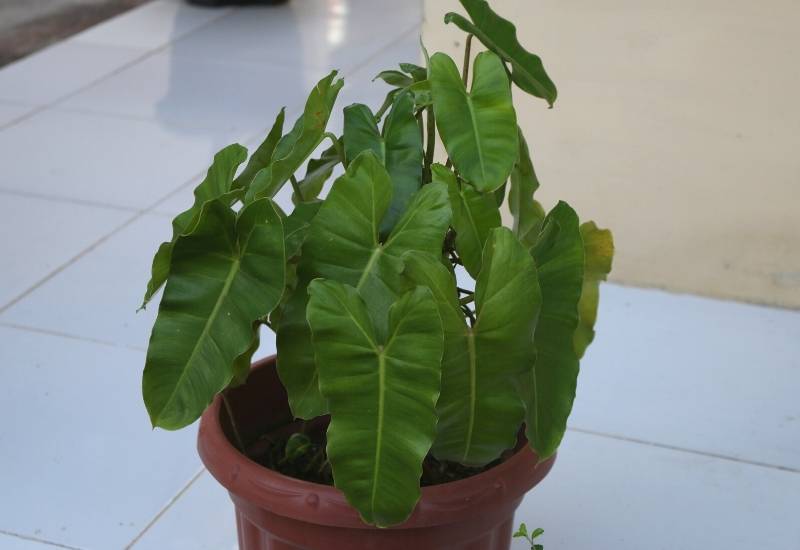
Blushing philodendron is another popular variety. It has strong looking elongated heart shaped leaves of a rich, deep green color.
They are also set off by the stems and the undersides of the leaves themselves, which, instead, have a purple shade.
These grow out, tilting on the stems, and forming large and very showy bushes of extremely lush foliage.
This is an excellent variety for living rooms and offices, and, in warm climates, you can even grow it on a terrace or balcony.
5: Philodendron Prince Orange (Philodendron ‘Prince Orange’)
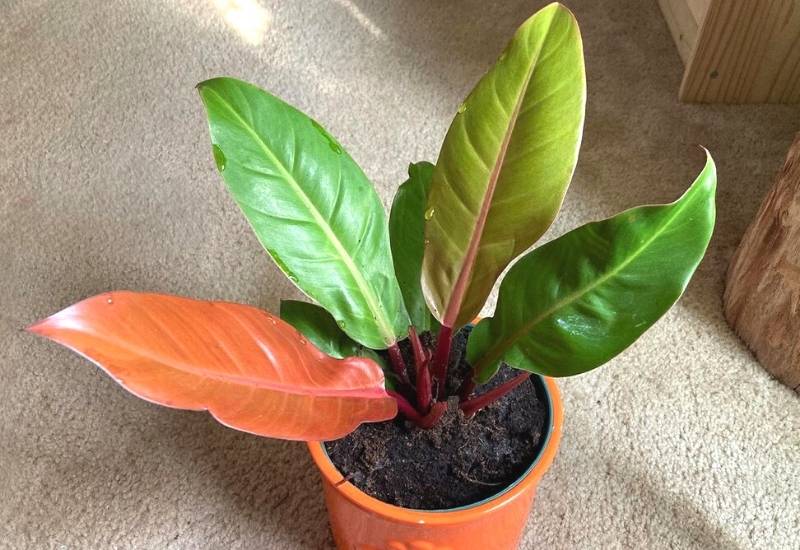
Philodendron Prince Orange is a cultivar with striking colors. The leaves are broad and spear shaped. They grow upright on short stems, so they look like they come from the ground.
But look at the colors! Some are bright green, but others will turn bright orange red! In between, you will get all the varying shades if orange and copper too!
This is a stunning philodendron variety, no doubt, but to make the best of its creative coloring, make sure it receives plenty of indirect but bright light! This will encourage the orange shades.
6: Philodendron Gloriosum (Philodendron gloriosum)
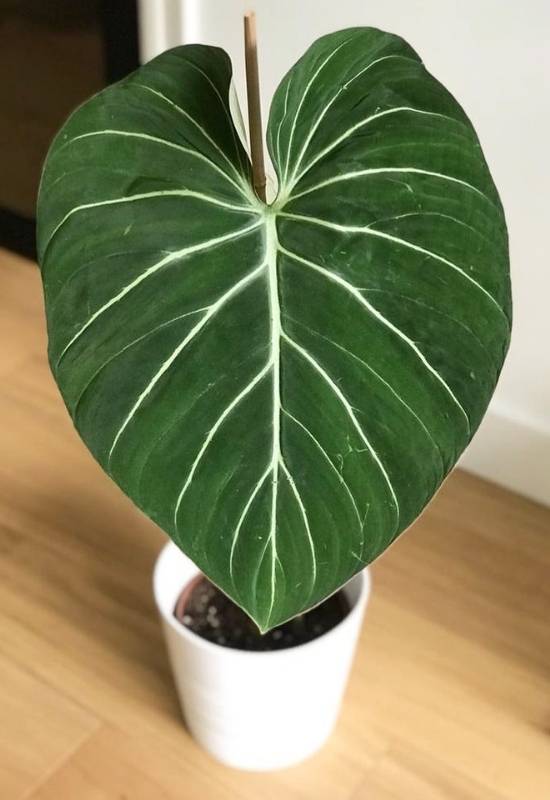
Philodendron gloriosum strikes you for its fleshy, large and smooth leaves. It is perfect as a houseplant, one of those that look like they are made of plastic…
The leaves are large and heart shaped, dark emerald green and with very decorative white leaves that add a lovely pattern to them.
But maybe the most striking feature of this plant is the massive size of these leaves. They can reach 2 feet in length (60 cm)! Definitely a plant for a large, space, maybe an important living room or office.
7: Philodendron Crassinervium (Philodendron crassinervium)
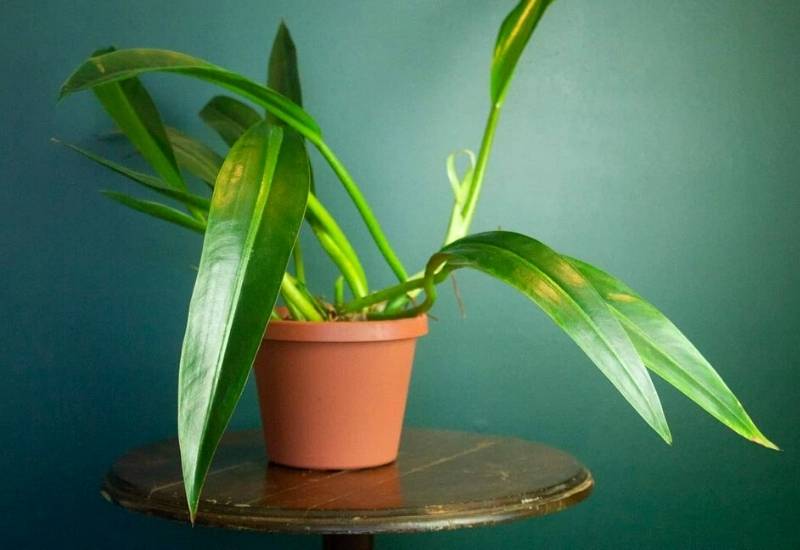
Philodendron crassinervium is a very original species from Brazil. I say “original” for a philodendron, because it does not look much like one. The leaves are oval and glossy green, and they grow along a creeping stalk. In terms of leaves, it looks like a clivia or an orchid.
Despite being a giant in its natural habitat, it remains short indoors, and it is easy to cut back. It is an easy plant to grow, easy to propagate and a bit of an outsider when it comes to philodendra.
8: Philodendron Lanciniatum (Philodendron lanciniatum)
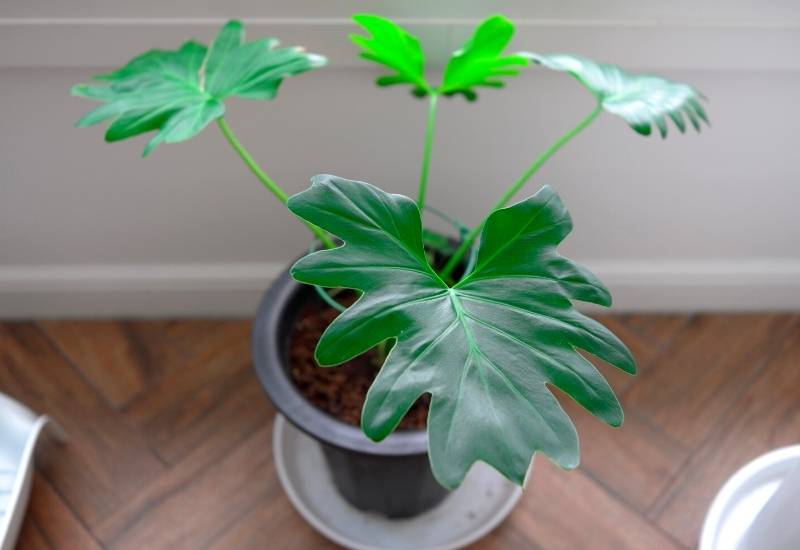
Philodendron lanciniatum has some of most original leaves ever! They are deeply lobed, and on the whole, they are “sort of triangular”.
That’s the overall shape, but its lobes are so strange that in the end, the leaf will look like it has three parts, a “muzzle” and two horns, a bit like a reindeer. Or, to some, it may look like a strange butterfly.
Add the very smooth texture, very decorative veins and the shiny bright green color and you het an excellent plant for a brightly lit, elegant and peaceful room. Your guests will be amazed when they cone to visit you!
9: Philodendron Esmeraldense (Philodendron esmeraldense)
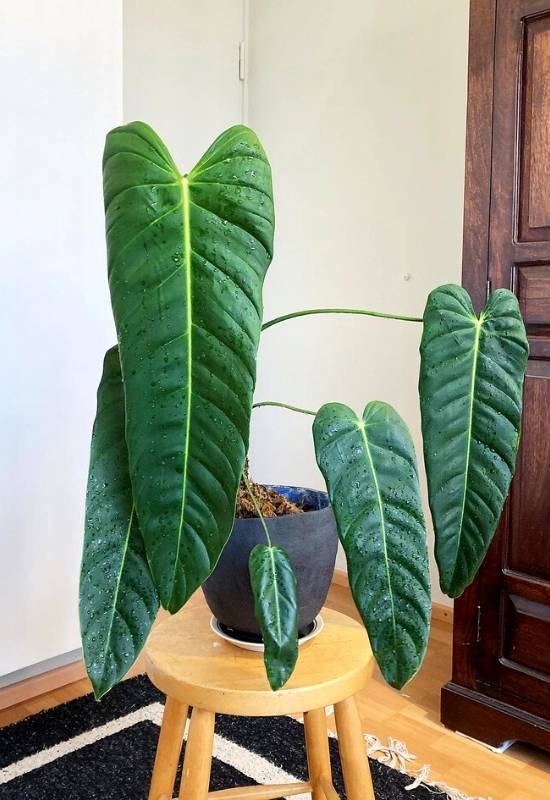
Philodendron esmeraldense is a new species. It was discovered in Ecuador as late as 2008. It has very long leaves (20 inches, or 50 cm) and in the shape of a very long heart.
They are bright green and with a leathery texture, like bog tongue. And like some animal’s tongues, they hang down from the stems they are attached to, almost reaching the ground with their tips.
They do not produce many leaves, but even one can be a very decorative presence on a work desk or on a table. Note that this species likes a fairly acidic pH, between 5.5 and 6.9.
10: Philodendron Subhastatum (Philodendron subhastatum)
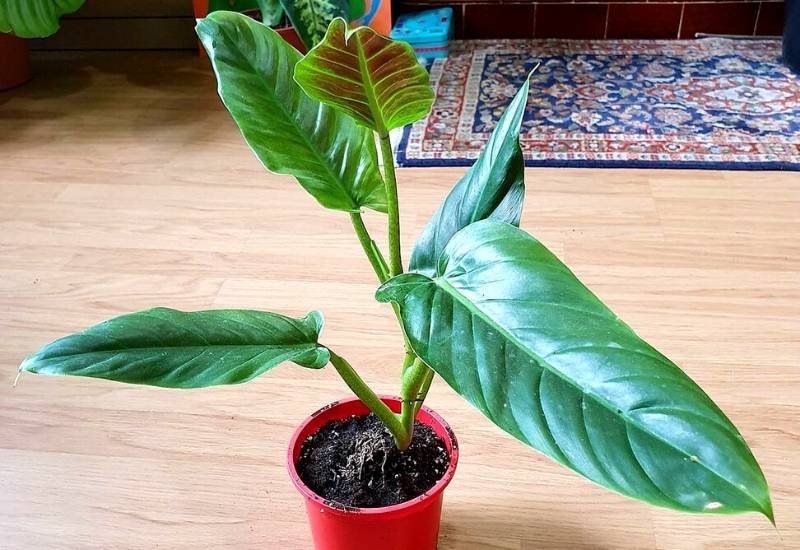
Philodendron subhastatum has broad and long, showy leaves. These have clear veins and they have an upright habit.
They are very glossy too, and so far, maybe it looks like many other varieties – but… the leaves are shiny green on top and orange, red or even purple on the underside, still with the beautiful veins in sight. Because of how they grow, the underside of the leaves is also quite visible.
It is easy to grow indoors and propagate but it has a small drawback. In fact, you may not find it very easily, not like other varieties, at least, because it is fairly rare.
11: Philodendron ‘Congo Rojo’ (Philodendron ‘Congo Rojo’)
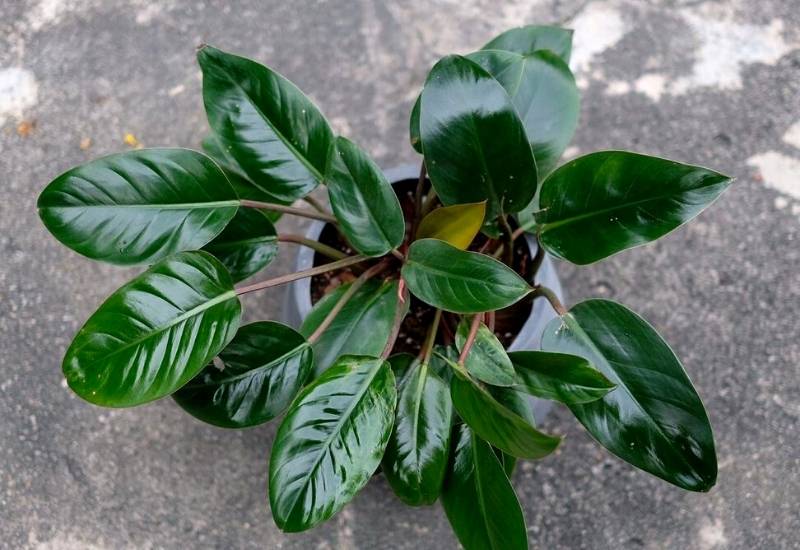
The cultivar philodendron ‘Congo Rojo” will strike you for the elegant and original color of its leaves.
They are almost black, by which we mean a very dark shade of brown purple, with green undertones. They are elliptical, long, shiny and leathery and they grow upright and then arch a bit, forming beautiful shrub like clumps.
This is the variety you want in a very modern, artistic room, maybe even in a minimalist room, or one with very sleek, modern furniture. Remember that black exalts the lines and sculptural quality of plants!
12: Philodendron Grazielae (Philodendron grazielae)
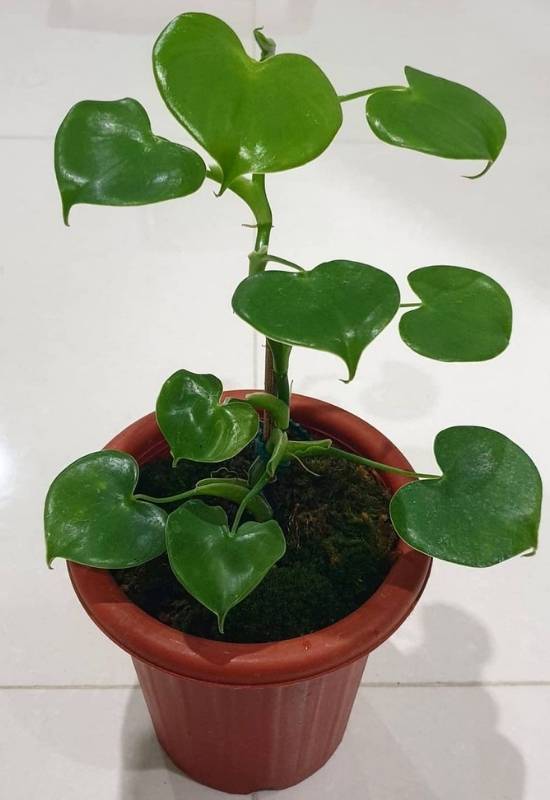
Philodendron grazielae is a very sweet looking and playful philodendron variety. It has many really glossy, bright green and hear shaped leaves that look like they are made of rubber.
This trailing philodendron grow pointing down from the vines of this beautiful plant, and they look great in hanging baskets.
This is the type of philodendron you want to grow to please your children. And even if you do not have any children, this sweet hearted green companion can bring out the child in you – or any one else!
13: Philodendron Brandtianum (Philodendron brandtianum)
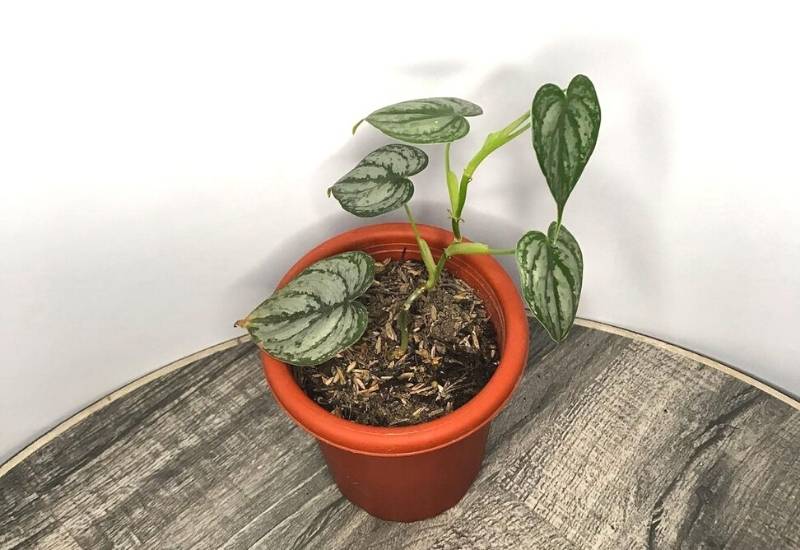
Philodendron brandtianum is a variety you will love for the variegation of its leaves. It terms of shape of the leaves and habit, it looks fairly similar to heartleaf philodendron.
But there is a big difference in the coloring. Brandtianum has olive green leaves with wide stripes of silver between the veins.
This elegant and striking pattern makes it ideal for very elegant rooms, even modern settings, offices and entertainment places where class is the message you want to convey.
14: Moonlight Philodendron (Philodendron‘Moonlight’)
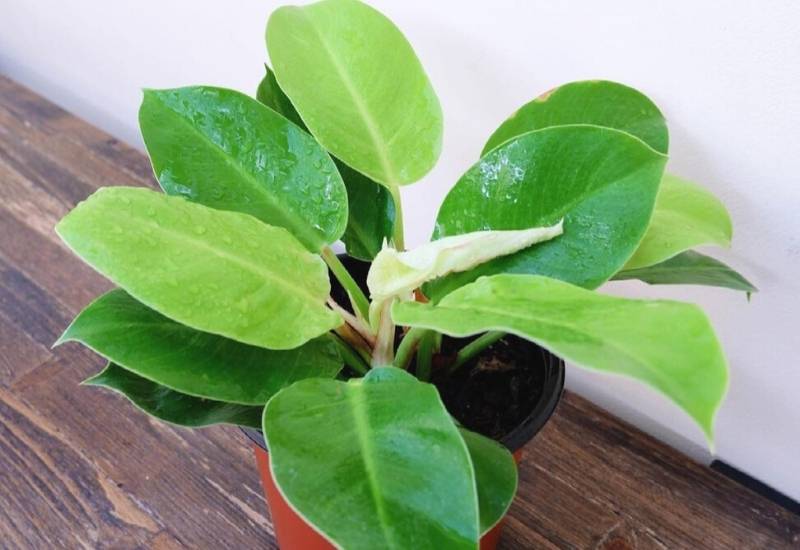
Philodendron ‘Moonlight’ is a cultivar with an energetic and bright appearance. The pointed leaves are very smooth and glossy.
They come from the base of the plant on stems that unfurl. When they are young, they are lemon green, then they become darker, pea green. The ensemble is a lively, fresh and energetic clump.
This variety is perfect to bring light as well as freshness to a room that needs it. It has that slightly “acidic” look, reminiscent of citrus fruit, so, pungent but pleasant.
15: Philodendron Micans (Philodendron micans)
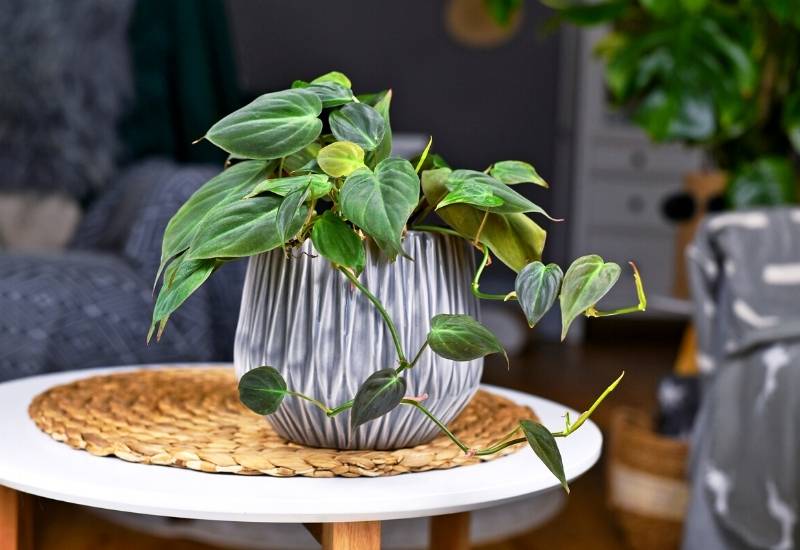
Philodendron micans has a special quality for this genus: the leaves are covered in a tiny layer of hairs, like an almost invisible fluff.
This is very unusual, but it gives the sweet, heart shaped leaves of this plant an iridescent quality.
The leaves have beautiful light green veins, but they can be of many shades of green and they tend to bronze. The undersides are red when young.
Exploit the velvety quality of the leaves and its bronze coloring; you can use it as a “living statue” in many types of rooms, including modern ones, thanks to the coloring, but also old fashioned ones due to the velvety texture of the leaves.
16: Philodendron Birkin (Philodendron ‘Birkin’)
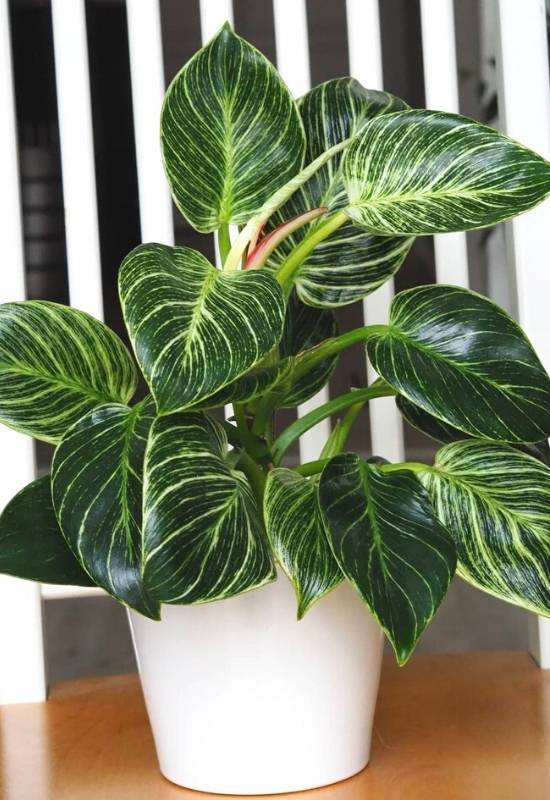
Philodendron ‘Birkin’ has striking pin stripes that start from the center of the heart shaped leaves and lead to the edges.
The stripes are very thin and intense, with dark and light green shades. The plant has an upright habit, with a central stem where all the leaves are attached.
It is a very de decorative variety, perfect for most room designs, and you will enjoy looking at how each leaf turns out to be, because none has exactly the same pattern.
17: Florida Ghost Philodendron (Philodendron ‘Florida Ghost’)
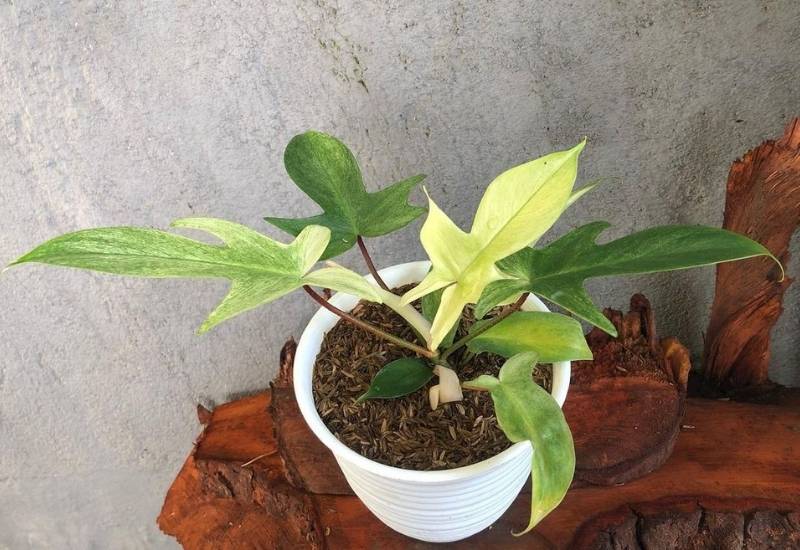
Philodendron ‘Florida Ghost’ is a shape shifting cultivar. The leaves, in fact, don’t have one shape… The can be lance shaped or lobed taking different forms as the plant pleases.
The colors too are surprising. Some leaves are emerald green, others have a thin pattern of different greens on them, yet others have a green and cream pattern, finally, you also get cream ones. And you can even get fully white leaves!
This is a very playful and interesting plant with a surreal quality. Certainly the little green (and cream) friend you want to amaze your guests, because it looks like a plant from Planet Mars…
18: Window Leaf Philodendron (Philodendron lacerum)
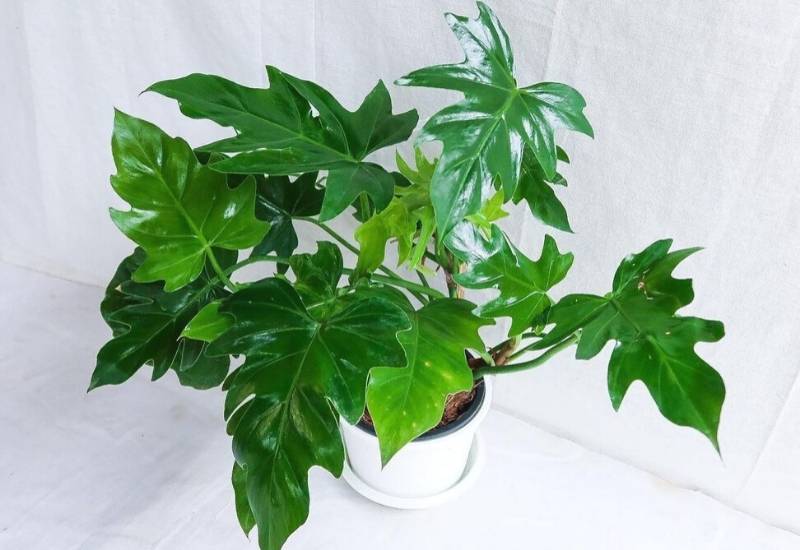
When I look at window leaf philodendron, it reminds me of an African mask. The huge, lobed and rubbery leaves hang down from the strong petioles, showing off their shiny hunter green color and beautiful veins. The edges look fringed, and the foliage reflects light with wonderful effects..
It is a very, very showy variety of philodendron. Wherever you put it, it will take center stage, It looks better against a neutral, light colored background, with lots of space to show off its impressive leaves. Note that it will need supports or the weight of the leaves may ruin the plant.
19: Tri-Leaved Philodendron (Philodendron tripartitum)
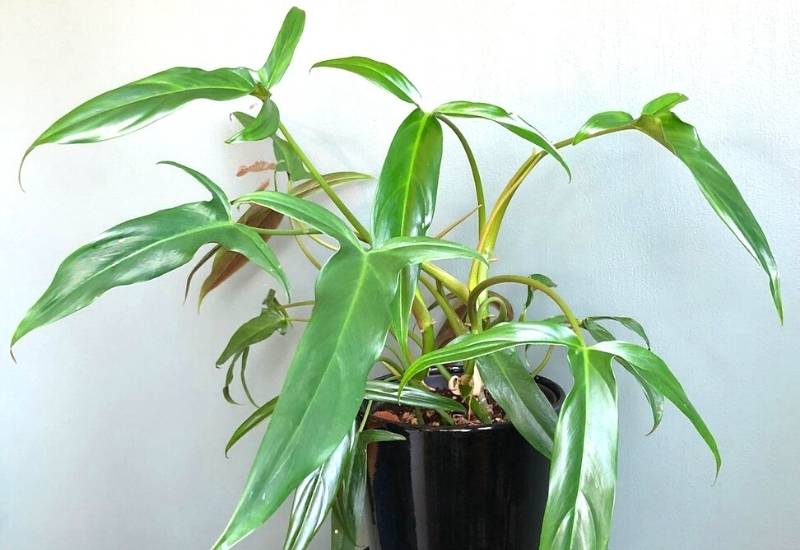
Tri-leaved philodendron has very original leaf shapes. In fact, each leaf looks like it is made up of three different leaves, two at the sides by the petiole, and one in the center.
This is because the leaf actually has very, very deep lobes. They are light emerald green in color and they also have beautiful veins.
Tri-leaved philodendron is growing in popularity at the moment. Maybe people appreciate its light but elegant appearance, which adapts well to most places, even as a “gentle” background presence, unlike some other philodendrons.
20: Philodendron Majesty (Philodendron ‘Majesty’)
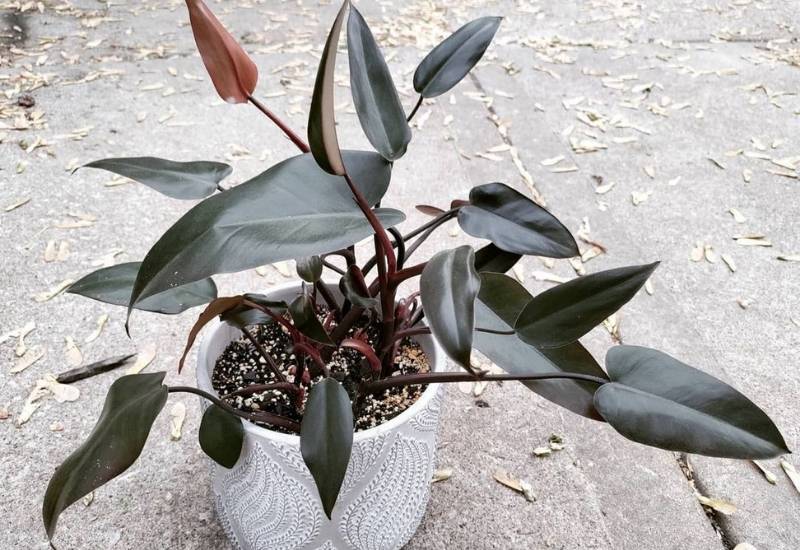
We close this list with royalty: Philodendron ‘Majesty’. A black queen, you could say, thanks to its very dark and shiny elongated heart shaped leaves.
So dark in fact, that they almost look black. And so shiny that they look like reflecting surfaces. Younger leaves will be copper red, which also ads to the extreme beauty of this plant.
This is a living sculpture, not just a plant. It is a work of art you want to display in full sight. It would look at ease in a museum, to give you an idea of the setting this plant could be suitable for.
Superlative Philodendrons – World Record Beating Philodendrons!
Philodendrons are so many and so strange that there are many world records within this genus, and here they are for you. I didn’t forget! I said there would be a surprise and here it is: the longest, the rarest, the most expensive…
21: The Longest Philodendron Vine in the World (Philodendron cordatum?)
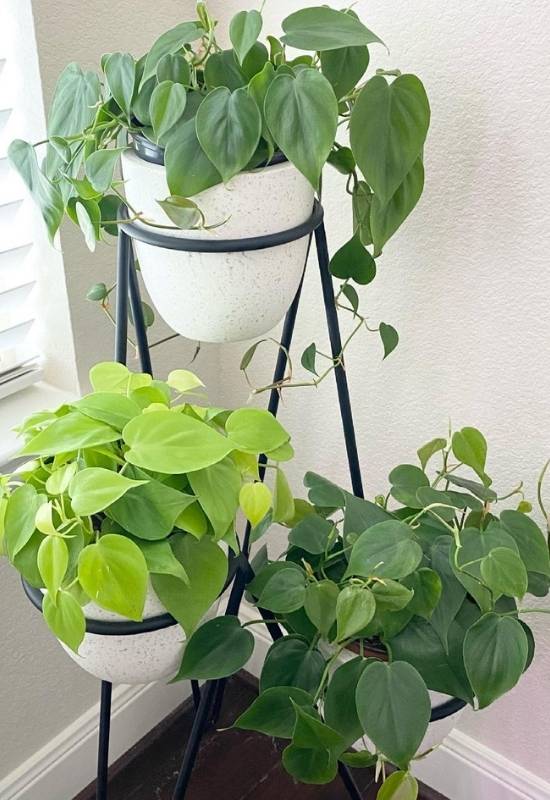
The longest philodendron vine in the world is in Amhurst, Massachusetts. Experts are not sure about the species, but the overall agreement is that it’s a Rhododendron cordatum.
Hold on though, this plant has another world record, it is actually the longest monocot in the world!
Philodendron cordatum has beautiful heart shaped leaves with a pointed tip. And on this specimen, they are really a lot!
I haven’t told you how long it is yet. Hold yourself fast, because it’s an impressive 1,114 feet long (or 339.55 meters) long! Actually – that was in 1984, last time it was measured.
On the whole, this giant weighs 250 lbs, or 113.6 Kg. It looks like it is so long thanks to lovcal conditions, and that in the wild it may never reach this length.
22: The Rarest Philodendron in the World (Philodendron plowmanii)
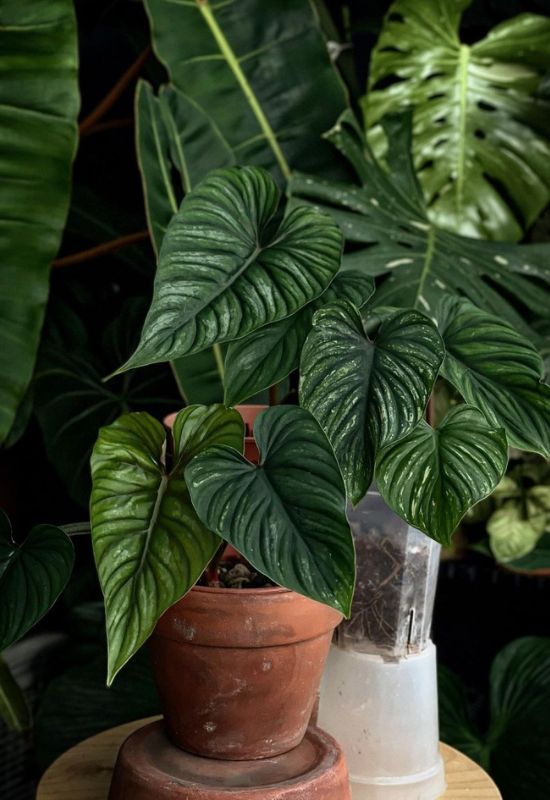
Philodendron plowmanii is rarest philodendron variety in the world and is also very sought after because it is beautiful. It is a terrestrial creeper, which means that it grows on the ground.
But it produces large emerald green heart shaped leaves that come on erect petioles. The leaves have also beautiful deep veins that give it a soft and “wavy” texture.
Rare though it is, you ca still buy this philodendron. It will set you back about $150 for a single small plant, so you’d better treat it well.
It is of course ideal as a special centerpiece plant, given its cost. Also, make sure no one ingests any part of it, because it is also very toxic.
23: The Oldest Indoor Philodendron in the World (Lacy Tree Philodendron, or Philodendron bipinnatifidum)
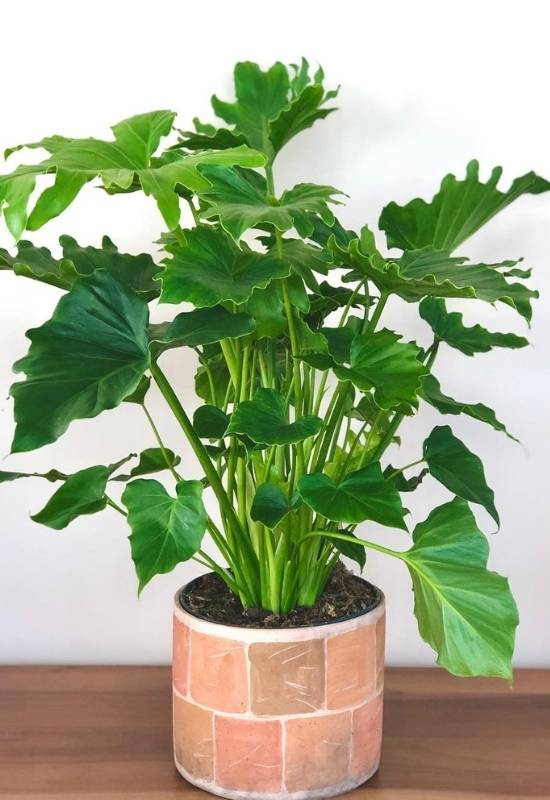
The oldest recorded philodendron grown in someone’s home is a lacy tree philodendron. We don’t know the oldest wild on.
But we do know that Ms. Ronna Scoratow has had a specimen of the popular, lace leaved Philodendron bipinnatifidum for a whopping 40 years!
It is very difficult to grow a houseplant for very long periods of time. In fact, while wild trees can live for thousands (12,000 actually!) years, the lifespan of indoor plants is much shorter.
But care, constant growing conditions and lots of love will help a lot along the way.
24: Most Expensive Philodendron (Philodendron minima variegata)
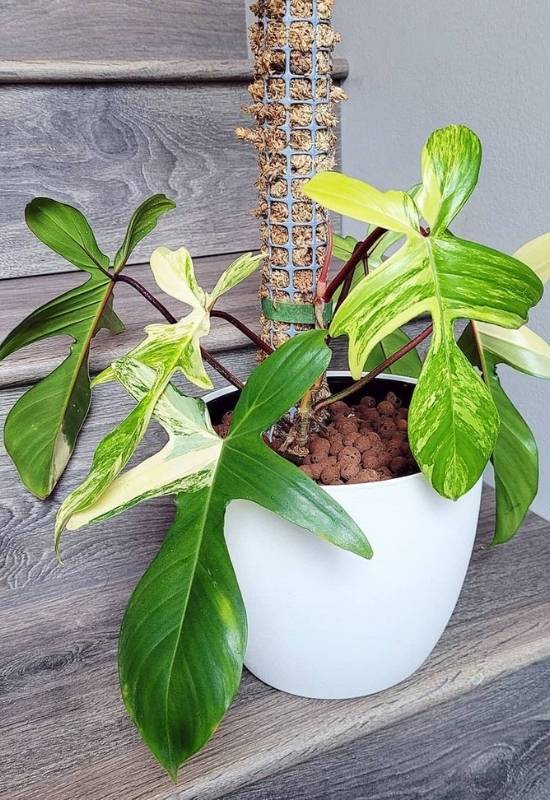
The most expensive philodendron plant ever sold belongs to a fairly unassuming small species, and it’s a variegated Philodendron minima.
It has sweet looking, fairly simple pinnate leaves that grow from the ground. The species has light green foliage, but the variegated variety has two colors: light green and a cream yellow color.
One plant was sold sold on the site Trade Me in New Zealand for a whopping $8,150! This is not much compared to some orchids that cost millions, but surely it is not the average plant you buy on the way back from the department store!
25: Largest Philodendron Leaf in the World (Philodendron maximum)
The easiest philodendron to recognize is Philodendron maximum because its leaves are just massive. This species from Bolivia, Ecuador and Brazil has large elongated hear shaped leaves that look very strong and very shiny. The color varies in tonality from light green to hunter green according to the light.
I know… you have been waiting to know how big the leaves are… It does depend on the individual plant, the climate, the pace, but they can easily reach 3 feet wide (90 cm) and 5.4 feet long (165 cm).
Ideal for a large room where you need a colossal presence. Certainly not a coffee table plant!
The Tropical World of Philodendron
No plant can recreate that lush, rich tropical look with its leaves like philodendron. And with almost 500 natural species and many hybrids and cultivars to choose from, the range is huge. You can see that some are impressive, some sweet looking, some even have black leaves!
Now you can recognize 20 amazing varieties, sure there is one that suits you pr needs…
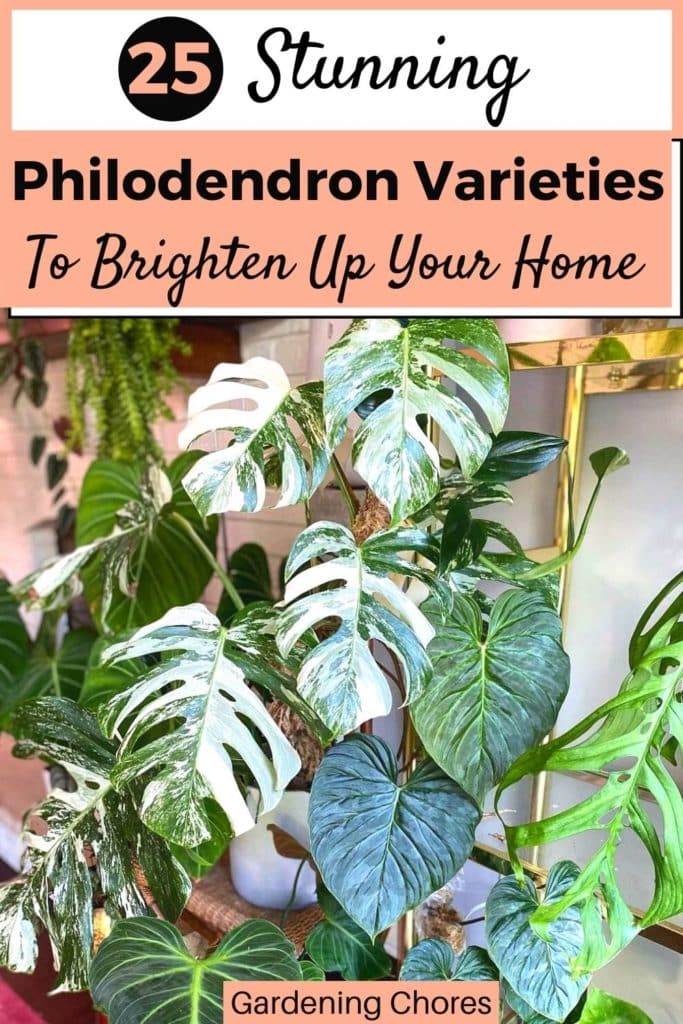

Written By
Amber Noyes
Amber Noyes was born and raised in a suburban California town, San Mateo. She holds a master’s degree in horticulture from the University of California as well as a BS in Biology from the University of San Francisco. With experience working on an organic farm, water conservation research, farmers’ markets, and plant nursery, she understands what makes plants thrive and how we can better understand the connection between microclimate and plant health. When she’s not on the land, Amber loves informing people of new ideas/things related to gardening, especially organic gardening, houseplants, and growing plants in a small space.

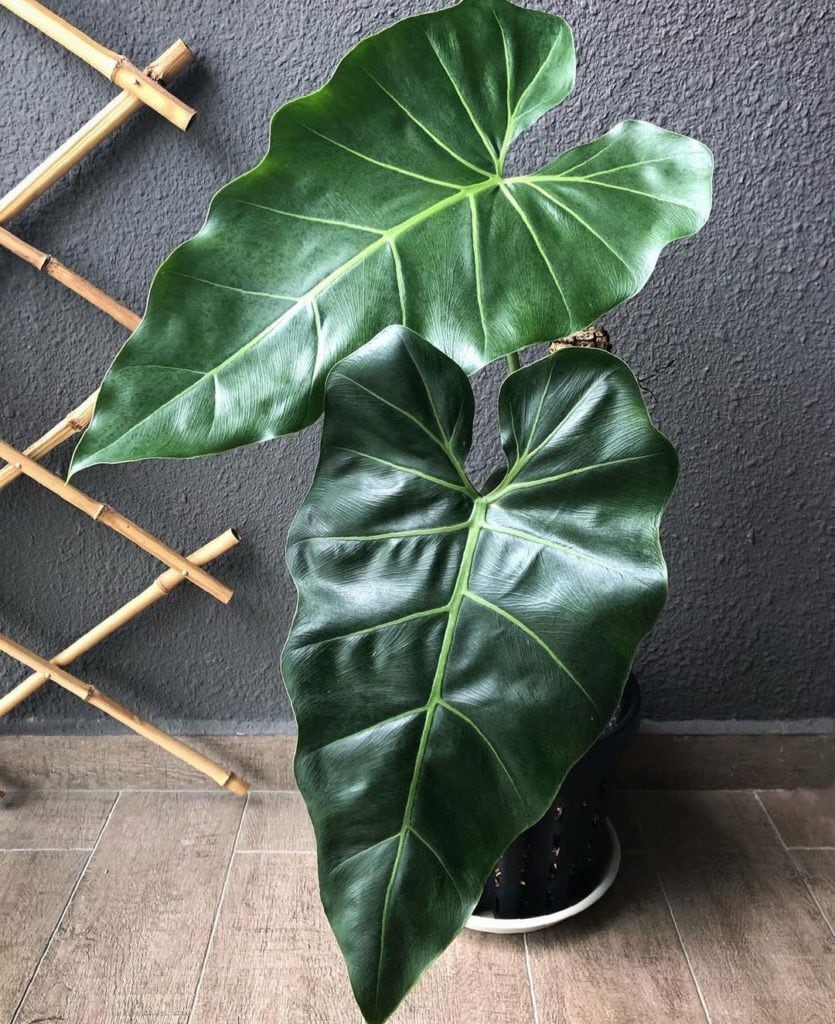
I just lost my wife and I’ve got all kinds of different Lilies and philodendrons and stuff and I need to learn how to grow them and take care of them
Thanks for trauma dumping on us
You’re rude for no reason. Have the day you deserve.
I fear you don’t comprehend the difference between trauma dumping and mourning, and I don’t know this ‘us’ you’re referring to.
You are a disgusting human. Exactly, have the day you deserve!
It takes consistent attention from you when you have a lot of plants. Is there a specialty plant store in your area? Go in often and look at how the soil is watered and how the plants are stabilized. I hope you’re a handyman because plants don’t stay small! What area do you live near that might have plant clubs? Ask the people at the specialty plant stores. Give me a holler and show me some pictures. God bless you and keep you! I am a widow also. I am 75 years old and I come from a farming family that lived in South Dakota before North and South were separated. It’s amazing how green thumbs are inherited! Stay safe.
I hope you find comfort in taking care of what I assume was her passion. Condolences.
Beautiful examples and worthy info. I have a question and hope you can help. I purchased a horse head philodendron a little over a year ago. It’s grown many leaves and is very healthy. I wonder however why all of the stems and leaves are growing downward. Should I pull them upright and somehow secure them? Is there a sturdy floral tape available? I would appreciate any suggestions you can give me.
Hi
Interesting article. But just to clarify a thing, philodendron would mean “love for trees” rather than “tree of love”.
They can be (hemi)epiphytes, meaning they can grow/climb on trees, so the name of the genus “philodendron” is better translated as “love for trees” or “lover of trees”.